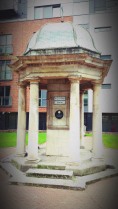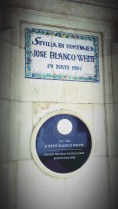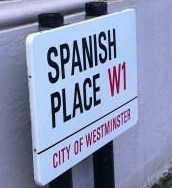
I’ve been thinking hard about the ideal first post for this new space, but it was only when I went back to Liverpool last week and found myself retracing a very familiar walk, that I realised – of course! What better way to kick off my exploration of Hispanic Britain than by introducing you to the first example I ever saw of an actual, public commemoration of what Eliga H Gould has called the ‘entangled histories’ of Britain and Spain.*
I lived in Liverpool for nine years, between 2004 and 2013, and on every working day, my daily commute took me on a 15-minute walk up the hill from Central Station to the University campus. Normally I headed straight for my side of campus, but just occasionally, for variation, I’d linger along the broad curve of Mount Pleasant with its Georgian townhouses, looming gothic YMCA and the cluster of former convent buildings that now house John Moores University. And one day early on, I don’t know why, but I stopped and entered the little garden with an elegant domed memorial at its centre (above), which I’d often passed but never really noticed [see its location here].

As I learned from the plaques mounted on the memorial, this is the former site of the Renshaw St Unitarian Chapel, opened in 1811 and closed in 1899, and since 1906 known as Roscoe Gardens in memory of one of the chapel’s most prominent former worshippers. But alongside the solemn memorials to the vanished congregation, was something quite different: a colourful azulejo or Spanish tile, with the name José Blanco White picked out prominently in blue. And it turned out that José Blanco White, a Spanish theologian and general contrarian whom I’d come across in passing and had always associated with London’s early-19th-century Spanish exile community, had spent the last six years of his life in Liverpool, cared for in his final days by another of Liverpool’s wealthy Unitarian families, the Rathbones.
Don José’s twin plaques, placed by his native city of Seville and his adopted city of Liverpool, demonstrate his status as a rare Anglo-Spanish figure whose memory is cultivated both in Spain and in the UK. It’s unusual, I think, to find such a public commemoration in the UK of such an inherently Anglo-Spanish figure – in fact, I can’t think of any more examples that aren’t connected with Britain’s military or naval exploits in Spain. If you know of something – a plaque, a monument, a memorial – I would love to hear about it – I am ALWAYS up for a field trip! In the meantime, read on for a brief biography of Blanco White and an account of his various residences in Liverpool, in (partly) his own words.

Biography
José Blanco White (right) is, without a doubt, the best known of all Liverpool’s Luso-Hispanic residents. Theologically and personally restless, his life and work illustrate the interconnectedness of Anglo-Hispanic cultural and family networks. He was born José Blanco Crespo in Seville in 1775, descended from an Irish Catholic family whose original family name, White, had been Hispanicized as Blanco. He trained for the Roman Catholic priesthood and was ordained in 1799 at the age of 24, but swiftly became disenchanted with the Church. Although he was involved with the Spanish resistance to Napoleon’s invasion of Spain in 1808, White had no faith in the Spanish provisional government, and in 1810 he left Spain for England, where he settled among the large Spanish exile community in London.
In London, Blanco White became friendly with the powerful Hispanophile Henry Fox, 3rd Baron Holland , and began to publish articles, essays and translations for both English- and Spanish-speaking audiences. In 1826, he moved to Oxford and joined Oriel College, where he became close to John Henry Newman
, and began to publish articles, essays and translations for both English- and Spanish-speaking audiences. In 1826, he moved to Oxford and joined Oriel College, where he became close to John Henry Newman . White had converted to Anglicanism soon after his arrival in England, and when in 1831 another of his friends, Richard Whately
. White had converted to Anglicanism soon after his arrival in England, and when in 1831 another of his friends, Richard Whately , was appointed Anglican Archbishop of Dublin, White went to live with him in Ireland. By 1835, he had become unhappy with the Anglican Church and in January that year, he left Dublin for Liverpool, where he would spend the final six years of his life.
, was appointed Anglican Archbishop of Dublin, White went to live with him in Ireland. By 1835, he had become unhappy with the Anglican Church and in January that year, he left Dublin for Liverpool, where he would spend the final six years of his life.
White arrived in Liverpool in 1835 and lived there for only six years. He appears on the whole to have had limited contact with the city’s other Hispanic residents, but he did enjoy a longstanding friendship with Clemente de Zulueta, a member of the extensive Basque merchant family with interests in Cadiz, London, Liverpool and – notoriously – Cuba. Clemente ran the Liverpool branch of the family business, and White stayed at his home at 56 Seel St during his first days in Liverpool. On 31 January, he declared:
I do not intend to leave Liverpool. The circumstance of its being a mercantile town, and my having only two or three persons who know me here, will keep me as much as possible out of the immediate contact of that intolerance, which would spare me only at the price of my honesty (Life, Vol. II: 92).
White’s desire to avoid ‘intolerance’ reflects his history of leaving behind social and family ties on moving between churches. He now eagerly joined yet another social and religious circle, as he became a member of Liverpool’s growing Unitarian congregation, which was patronized by the powerful Rathbone family.
Despite the support and friendship he found in Unitarian circles, White’s years in Liverpool were not happy. He was frequently unwell and moved house often, seeking better or quieter or brighter lodgings. Leaving Zulueta’s house after a few days, he first took up lodgings at 25 Upper Parliament St, although he ‘found them uncomfortable’ and within six weeks had removed around the corner to 5 Chesterfield St, where on March 3 he was pleased to note in his journal that
this is the twenty-fifth anniversary of my arrival in England: the first that has found me in a house of my own – solitary – but … in peace (Life, Vol. II: 105).
Two days later, he wrote to a friend that,
I have taken a cheap house, which, by means of very little furniture, I have made habitable; and here I am, wishing for nothing but that I may be allowed to died in peace; not in peace from theological obloquy, for that I think it my duty to encounter, but free from the necessity of looking for another place of refuge (Life, Vol. II: 107).
Between 1836-1840, White resided at 22 Upper Stanhope St, from where, on 2 September 1840, he recorded in his journal his removal to Carlisle Cottage in Whitfield St, on the rural outskirts of the city:
Left the house (Upper Stanhope Street), accompanied by Mr Thom, and carried between three men. The rooms in the Cottage look cheerful, but I feel quite knocked up. The bird [his pet canary, Dickey] was very much frightened, though he was brought by Margaret [his servant] in a coach. The house is quiet: passed the night tolerably.
He remained at the Cottage until February 1841, when, in his final sickness, he was moved to Greenbank, the home of William Rathbone (now a University of Liverpool Hall of Residence ), where he died on 20 May 1841. His friend and editor JH Thom records:
), where he died on 20 May 1841. His friend and editor JH Thom records:
He remained some days longer, chiefly in the state of one falling asleep, until the morning of the 20th, when he awoke up, and with a firm voice and great solemnity of manner, spoke only these words:- “Now I die.” He sat as one in the attitude of expectation, and about two hours afterwards – it was as he had said. On Monday the twenty-fourth of May he was interred, according to the instructions of his Will, in the burial-ground attached to Renshaw-street Chapel, Liverpool, in the 66th year of his age (Life, Vol. III: 310).
________________________________________________________________________________-
Read more:
The Life of the Rev. Joseph Blanco White: Written by Himself, with portions of his correspondence. London: J Chapman, 1845 [Full text available at The Internet Archive: Vol. I (1775-1832) / Vol. II (1833-1837)
/ Vol. II (1833-1837) / Vol. III (1838-1841)
/ Vol. III (1838-1841) ]
]
* Gould develops the idea of ‘entangled’ histories in his wonderful, provocative essay, “Entangled Histories, Entangled Worlds: The English-Speaking Atlantic as a Spanish Periphery.” American Historical Review 112.3 (2007): 764–86. Read it here.

[…] Liverpool might not have left many physical traces – the memorial to José Blanco White I discussed in my last post is a striking exception – but having spent so much time tracking down the residences and […]
Well done on the new blog. It’s a great idea and I look forward to following your obsessions (or researches).
Reblogged this on Manolobis's Blog.